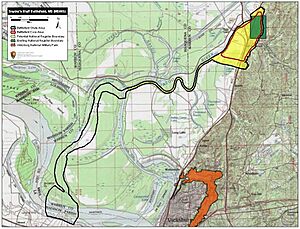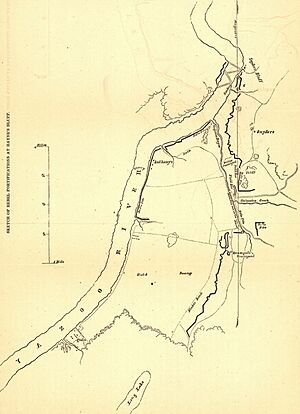Battle of Snyder's Bluff facts for kids
Quick facts for kids Battle of Snyder's Bluff |
|||||||
|---|---|---|---|---|---|---|---|
| Part of the American Civil War | |||||||
 Map of Snyder's Bluff Battlefield core and study areas by the American Battlefield Protection Program |
|||||||
|
|||||||
| Belligerents | |||||||
| Commanders and leaders | |||||||
| William T. Sherman | Louis Hébert | ||||||
| Units involved | |||||||
| Blair's Division, XV Corps Mississippi River Squadron |
Snyder's and Drumgould's Bluffs defenses | ||||||
The Battle of Snyder's Bluff happened from April 29 to May 1, 1863. It was part of the Vicksburg Campaign during the American Civil War. The main goal of this battle was to trick the Confederate army.
Union General Ulysses S. Grant planned to move his army. He wanted to cross the Mississippi River south of Vicksburg, Mississippi. To hide his real plan, General William T. Sherman led a group of soldiers. Their mission was to make a fake attack (a "feint") on Confederate defenses. These defenses were at Snyder's Bluff and Drumgould's Bluff along the Yazoo River.
Sherman's soldiers and a naval force entered the Yazoo River on April 29. The next day, they got close to the Confederate defenses. Union ships fired at the defenses in the morning. In the afternoon, the soldiers tried a land attack. This attack didn't achieve much. It also failed to convince the Confederates that it was a real attack.
On May 1, the Union soldiers tried more probes. But Sherman got new orders from Grant. He was told to bring his troops back to the main Union army. This was because of what was happening near Grand Gulf. The Union ships fired more effectively on May 1. However, the whole operation didn't fool the Confederates. They still knew it was just a distraction.
The Vicksburg Campaign ended in a Union victory on July 4, 1863. This was a very important moment in the war.
Template:TOC limit=3
Contents
Why the Battle Happened
The Anaconda Plan and Vicksburg
Early in the American Civil War, the Union army had a plan. It was called the Anaconda Plan. This plan aimed to defeat the Confederate States of America. A big part of this plan was to control the entire Mississippi River.
By early 1862, the Union controlled much of the Mississippi Valley. They had captured New Orleans, Louisiana. But the city of Vicksburg, Mississippi, was still held by the Confederates. Vicksburg was very important. It was a strong defense point on the river. It also connected the two halves of the Confederacy.
The Union Navy tried to take Vicksburg in May 1862. They were not successful. Later, a joint army and navy group tried again. But they realized they needed more soldiers. An attempt to dig a canal to bypass Vicksburg also failed.
Grant's First Attempts
In late November 1862, General Ulysses S. Grant led about 40,000 Union soldiers. They started moving south from Tennessee towards Vicksburg. But Grant had to retreat. Confederate raids destroyed his supplies.
Meanwhile, another Union group went down the Mississippi River. This group was led by General William T. Sherman. Sherman's men went up the Yazoo River. They fought with Confederate soldiers defending hills near Chickasaw Bayou. On December 29, the Union attack was strongly defeated. This was the Battle of Chickasaw Bayou. Sherman's men pulled back on January 1, 1863.
Grant's New Plan for Vicksburg
By late March 1863, other attempts to get around Vicksburg had failed. General Grant then thought about a new plan. He decided to move his army south. They would march along the west side of the Mississippi River. Then, they would cross the river below Vicksburg. This would allow them to attack the city from the south.
This march began on March 29. Other Union actions helped hide Grant's real plan. These included Steele's Greenville expedition and Grierson's Raid. Confederate commander John C. Pemberton was tricked by these fake attacks. He thought Grant was retreating.
By late April, Grant's main forces were moving into position. General Sherman's XV Corps was supposed to follow later. But Grant changed his mind on April 27. He planned an attack at Grand Gulf, Mississippi. He wanted to distract the Confederates from this attack.
So, Sherman and some of his troops were ordered to make a fake attack. This "feint" would be at Snyder's Bluff. Grant was a bit worried about this fake attack. He feared it might look like another defeat. But Sherman decided to go ahead with the plan.
The Battle at Snyder's Bluff
Preparing for the Fake Attack
Rear Admiral David Dixon Porter put Lieutenant Commander K. Randolph Breese in charge of the naval part of the operation. Breese wanted to wait for an ironclad ship called the USS Choctaw.
On April 28, General Francis P. Blair Jr.'s division got supplies. The Choctaw arrived around 5:00 pm. The expedition started the next morning. Ten troop transports carried the soldiers. Six of these ships had hay bales for protection. They also had two cannons each.
Eleven naval ships escorted the transports. These included the flagship USS Black Hawk, the ironclads Choctaw and USS Baron DeKalb, and other gunboats.
Fighting on April 30
The ships reached the Yazoo River on the afternoon of April 29. They stopped for the night. The next morning, the convoy moved again. One ship, the Petrel, stayed behind to guard against Confederate naval mines.
The fighting began around 10:00 am. The ironclads Baron DeKalb and Choctaw started firing. They targeted Confederate positions at Drumgould's Bluff. This bluff was about 1 mile (1.6 km) from Snyder's Bluff. Other Union ships also joined the firing.
Confederate defenses were led by Brigadier General Louis Hébert. He had 16 heavy cannons and strong trenches. A raft had been built to block the river, but it had washed away.
The Union ironclads could only fire their side guns. Hébert waited to open fire. He didn't want the Union to know his positions too quickly. Once the Confederates fired, their biggest guns hit the Choctaw. The Tyler was damaged and had to leave. The Choctaw was hit 47 times but wasn't badly damaged.
Union soldiers landed on shore during the bombardment. They tried to gather cattle, which caused a stampede. The Union gunboats then pulled back. Hébert reported that only two of his men were wounded. His defenses were not seriously damaged.
In the afternoon, some of Blair's soldiers landed. They could only move along a levee because of flooding. Confederate soldiers and artillery fired at them. The Union soldiers could not advance further. The Union's fake attack had not been very convincing. The Confederates suspected it was just a demonstration.
Fighting on May 1 and Retreat
On the morning of May 1, Sherman landed the 8th Missouri Infantry Regiment. They landed on the west side of the river. But a bayou and Confederate artillery fire forced them to retreat. Other Union regiments scouted Drumgould's Bluff. They found that the Confederates had made their positions even stronger.
Sherman and Breese decided to start firing the gunboats again at 3:00 pm. However, Sherman received an urgent message from Grant. The message said that the Union forces had passed Grand Gulf. Sherman needed to move two of his divisions for the main campaign.
Sherman put Blair in charge of the Snyder's Bluff operations. He ordered one division to guard a corridor. He also started moving his other two divisions south.
Around 3:00 pm, Union ships Tyler, Choctaw, and Black Hawk moved upriver. They shelled the Confederate positions. The Baron DeKalb fired from further downstream. This time, the Union fire was more effective. Two Confederate guns were knocked out.
Around dark, the Union ships stopped fighting. Blair's men left the area on transports around 8:00 pm. The gunboats followed them. Hébert reported that he had no casualties that day. The Tyler was the only Union ship hit during this exchange.
What Happened Next
Sherman later said his operation was very important. But historians say it didn't impress the Confederates much. The Confederates already knew it was a fake attack. While Confederates delayed sending help to Grand Gulf, this wasn't because of Sherman's feint. It was more due to poor decisions by Confederate officers.
On April 29, Union gunboats had attacked Confederate positions at Grand Gulf. But they couldn't silence all the Confederate guns. So, Grant simply moved his crossing point further downriver. He crossed at Bruinsburg, Mississippi.
On May 1, Grant's lead forces defeated a Confederate group. This was at the Battle of Port Gibson. This opened the way for them to move inland. Grant then changed his plan to approach Vicksburg. He moved towards Jackson, Mississippi. He then captured that city.
The defenders of Vicksburg fought Grant east of the city. This was at the Battle of Champion Hill on May 16. But they were defeated. Grant then started the Siege of Vicksburg on May 18. The Confederates surrendered Vicksburg on July 4. This was a major turning point in the American Civil War.
Images for kids



